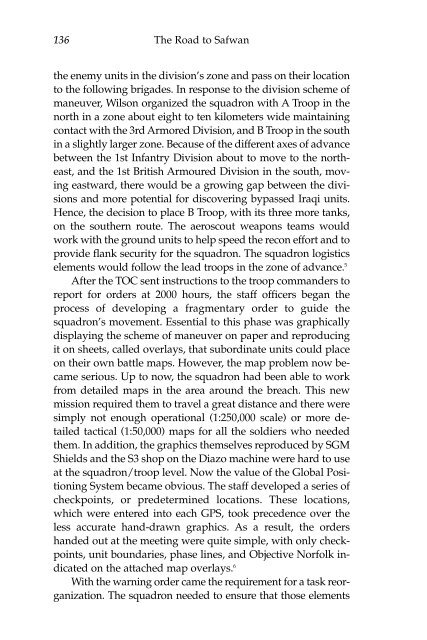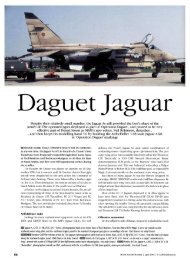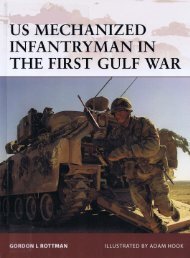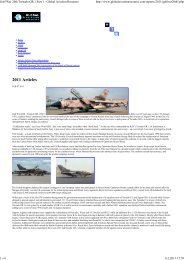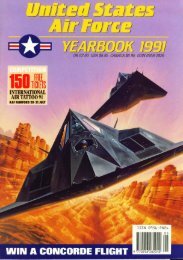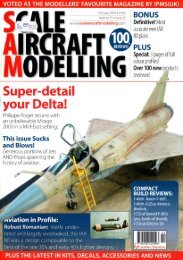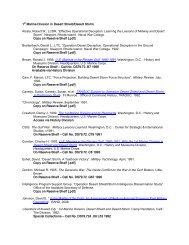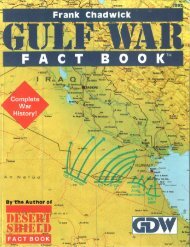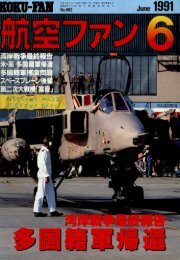The Road to Safwan: The 1st Squadron, 4th Cavalry in the 1991 ...
The Road to Safwan: The 1st Squadron, 4th Cavalry in the 1991 ...
The Road to Safwan: The 1st Squadron, 4th Cavalry in the 1991 ...
You also want an ePaper? Increase the reach of your titles
YUMPU automatically turns print PDFs into web optimized ePapers that Google loves.
136 <strong>The</strong> <strong>Road</strong> <strong>to</strong> <strong>Safwan</strong><br />
<strong>the</strong> enemy units <strong>in</strong> <strong>the</strong> division’s zone and pass on <strong>the</strong>ir location<br />
<strong>to</strong> <strong>the</strong> follow<strong>in</strong>g brigades. In response <strong>to</strong> <strong>the</strong> division scheme of<br />
maneuver, Wilson organized <strong>the</strong> squadron with A Troop <strong>in</strong> <strong>the</strong><br />
north <strong>in</strong> a zone about eight <strong>to</strong> ten kilometers wide ma<strong>in</strong>ta<strong>in</strong><strong>in</strong>g<br />
contact with <strong>the</strong> 3rd Armored Division, and B Troop <strong>in</strong> <strong>the</strong> south<br />
<strong>in</strong> a slightly larger zone. Because of <strong>the</strong> different axes of advance<br />
between <strong>the</strong> <strong>1st</strong> Infantry Division about <strong>to</strong> move <strong>to</strong> <strong>the</strong> nor<strong>the</strong>ast,<br />
and <strong>the</strong> <strong>1st</strong> British Armoured Division <strong>in</strong> <strong>the</strong> south, mov<strong>in</strong>g<br />
eastward, <strong>the</strong>re would be a grow<strong>in</strong>g gap between <strong>the</strong> divisions<br />
and more potential for discover<strong>in</strong>g bypassed Iraqi units.<br />
Hence, <strong>the</strong> decision <strong>to</strong> place B Troop, with its three more tanks,<br />
on <strong>the</strong> sou<strong>the</strong>rn route. <strong>The</strong> aeroscout weapons teams would<br />
work with <strong>the</strong> ground units <strong>to</strong> help speed <strong>the</strong> recon effort and <strong>to</strong><br />
provide flank security for <strong>the</strong> squadron. <strong>The</strong> squadron logistics<br />
elements would follow <strong>the</strong> lead troops <strong>in</strong> <strong>the</strong> zone of advance. 5<br />
After <strong>the</strong> TOC sent <strong>in</strong>structions <strong>to</strong> <strong>the</strong> troop commanders <strong>to</strong><br />
report for orders at 2000 hours, <strong>the</strong> staff officers began <strong>the</strong><br />
process of develop<strong>in</strong>g a fragmentary order <strong>to</strong> guide <strong>the</strong><br />
squadron’s movement. Essential <strong>to</strong> this phase was graphically<br />
display<strong>in</strong>g <strong>the</strong> scheme of maneuver on paper and reproduc<strong>in</strong>g<br />
it on sheets, called overlays, that subord<strong>in</strong>ate units could place<br />
on <strong>the</strong>ir own battle maps. However, <strong>the</strong> map problem now became<br />
serious. Up <strong>to</strong> now, <strong>the</strong> squadron had been able <strong>to</strong> work<br />
from detailed maps <strong>in</strong> <strong>the</strong> area around <strong>the</strong> breach. This new<br />
mission required <strong>the</strong>m <strong>to</strong> travel a great distance and <strong>the</strong>re were<br />
simply not enough operational (1:250,000 scale) or more detailed<br />
tactical (1:50,000) maps for all <strong>the</strong> soldiers who needed<br />
<strong>the</strong>m. In addition, <strong>the</strong> graphics <strong>the</strong>mselves reproduced by SGM<br />
Shields and <strong>the</strong> S3 shop on <strong>the</strong> Diazo mach<strong>in</strong>e were hard <strong>to</strong> use<br />
at <strong>the</strong> squadron/troop level. Now <strong>the</strong> value of <strong>the</strong> Global Position<strong>in</strong>g<br />
System became obvious. <strong>The</strong> staff developed a series of<br />
checkpo<strong>in</strong>ts, or predeterm<strong>in</strong>ed locations. <strong>The</strong>se locations,<br />
which were entered <strong>in</strong><strong>to</strong> each GPS, <strong>to</strong>ok precedence over <strong>the</strong><br />
less accurate hand-drawn graphics. As a result, <strong>the</strong> orders<br />
handed out at <strong>the</strong> meet<strong>in</strong>g were quite simple, with only checkpo<strong>in</strong>ts,<br />
unit boundaries, phase l<strong>in</strong>es, and Objective Norfolk <strong>in</strong>dicated<br />
on <strong>the</strong> attached map overlays. 6<br />
With <strong>the</strong> warn<strong>in</strong>g order came <strong>the</strong> requirement for a task reorganization.<br />
<strong>The</strong> squadron needed <strong>to</strong> ensure that those elements


